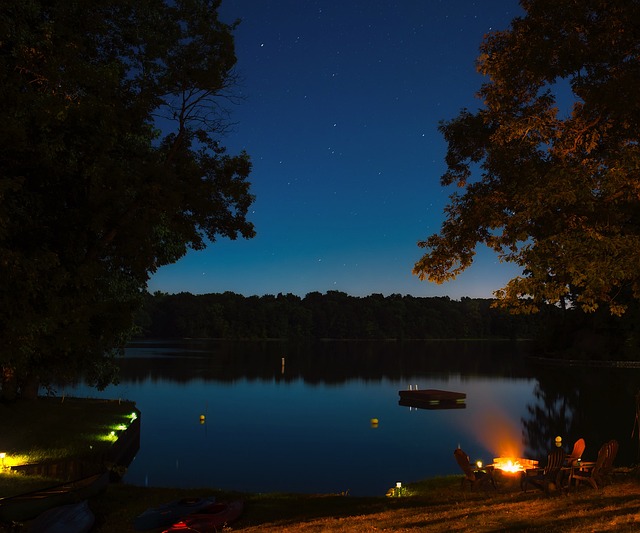When camping at a remote campsite that does not offer electricity, you will need to rely on campfires to keep you warm and provide some lighting. While starting and maintaining a campfire sounds easy, it is somewhat complicated. You need to know some tricks, especially if you want to keep a campfire going all night.
In today’s guide, I will tell you everything you need to know to create a long-lasting campfire. You can use six tricks to slow the burning process and keep the campfire going all night. So, if you want to learn more about the topics, I recommend you keep reading!
More...

How to Keep a Camp Fire Going All Night [or a Fire Pit!] - 6 Effective Ways For Long Lasting Fire
While cooking dinner or roasting munch mallows on the campfire, you must keep the fire roaring. The same goes for camping trips in the cold weather, when a fire is all you need to keep yourself from freezing.
As expected, campfires are essential for all cold-weather camping trips. If you plan on taking such a trip, you will need to learn how to keep the campfire from burning out down the night while also keeping it controlled so that it does not spread into a wildfire. Here are some tips that will help you achieve a lasting campfire:
1. Choose the best location
Finding a good location with good ventilation is crucial for the fire. It would help if you looked for a soft surface where you can create the fire pit. If you can use an existing fire pit, you should do your best to clean it up and start the fire there.
Under no circumstance should you leave dry grass or branches around the fire pit as they can easily catch on fire in case of wind. Clear out the area surrounding the fire before you try to start it.
2. Make a proper fire pit
Building a fire pit is more than just throwing a few rocks in a circle and starting a fire. To build long-lasting campfires, you must create a fire pit with enough ventilation to make the fire last. So, try to build a proper fire pit.
First, find larger rocks you can use as a boundary for your fire pit. Then, clean the surrounding area and set the rocks. If the area is too windy and you cannot find another spot you like, try digging a small hole where you would start the fire. It is better to be safe than to risk the fire spreading because of wind.
3. Use lots of rocks in the fire
After you start the fire, you will need to keep it burning for a long time without needing to look over it all night long. One of the best things you can use in this case is to gather smaller rocks and throw them into the fire. Rocks hold heat very well and can add more heat to your fire.
So, aside from the rocks you use for the fire pit, try to find some more rocks. After you get the fire started and get it to burn well, you should distribute the rocks throughout it. The burning fire will heat the rocks, and that will make the fire burns hotter and longer. How cool is that?!
4. Use slow-burning wood
Without needing to get rocks or worry about ventilation, you can keep your fire burning by using the correct type of wood. At home, you can use dry, seasoned wood that you prepare for a few months before burning it. At a remote campsite, you might not have such seasoned wood you can rely on.
This means you must find suitable wood to create your overnight campfire. Try finding larger birch logs, beech, oak, pine, maple, cedar, or cherry. These types of wood are known as slow-burning wood. They can help the fire burn long without you needing to add new wood constantly.
When starting fires, you can use the bark of the logs, dry leaves, pine needles, and similar things to have a more effective start. Then, add the logs on top of one another and let the fire provide warmth and light to the entire campsite.
5. Use the one-half-inch rule
There is a rule all campers need to know if they want their campfires to last for a long time – the one-half-inch rule. This rule states that a half inch of wood should burn for approximately one hour. But this rule does not apply to all situations, as there are certain variables.
Remember the half-inch to one-hour ratio, as this applies to most types of wood. The thicker logs will burn longer, so that ratio would be close to one inch per hour. The ratio will mainly vary between different types of wood, the amount of heat coming from the fire, and the ventilation.
6. Use the Tipi design
The tipi design is straightforward but very effective in creating lasting campfires. To make a tipi-style fire, you will need to create a fire pit, then set the logs in the form of a tipi, use dry leaves to start the fire, and let the logs burn as the fire develops.
This type of fire is somewhat like a self-feeding fire. You can also try using two ramps to make a whole self-feeding system, but that is a bit more demanding. Try looking up a video online to see if that is something you can do on your next camping trip. If you do not like it, stick to the easier tipi-style fire.

Safety: Should You Keep A Campfire Going All Night?
It is not advisable to keep a fire going all night, at least not in all situations. When camping at a remote campsite, several things could go wrong if you leave the fire burning all night without supervision.
Instead of leaving it to chance, it is better to use a few simple tricks to keep the fire going all night long without needing to worry that things would get out of hand. For example, make sure that the fire is nowhere near a forest. That way, even if a strong wind starts blowing during the night, there will be no chance for the campfire to spread. Also, remember not to light fires with strong winds - put that action off until the wind slows down.
Next, make sure that you clear out the space surrounding the fire. There should be no dry leaves, grass, or anything that could easily catch fire. Clean the area, create a shallow hole, and turn that hole into the fire pit.
Another thing you can do is always keep a bit of water around your campsite. That way, even if things get out of hand, you will have the water to extinguish the fire fast. If a stream or river is near your campsite, consider lighting the fire near the water source.
Never leave your fire unattended. If you want to do so during the night, ensure the flames are controlled at all times. Keep an eye on the fire – it takes only a second for things to turn for the worse.
Wrap-Up
To keep the campfire burning all night, use all the tips given in this guide. Find a good spot, create the best fire pit, ensure ample air circulation and enough slow-burning wood, and you will be good to go.
You need only a few things to get a long burning fire, but remember to always keep an eye on it. Fire is not something you want to play with, so make sure you are always careful and responsible when lighting and keeping fires burning all night.
- Are Merrell Shoes Good? – An Unbiased Review of Merrell Footwear - December 9, 2023
- Where Are Merrell Shoes Made? - December 9, 2023
- Camping in 40-degree Weather: Tips and Tricks - September 25, 2023

![Why Your Campfire Smokes So Much? [Quick Answers You Should Know] Why Your Campfire Smokes So Much? [Quick Answers You Should Know]](https://grandcircletrails.com/wp-content/uploads/2021/09/Why-Your-Campfire-Smokes-So-Much-1-150x150.jpg)
![How to Get Campfire Smell Out of Clothes? [Proven Ways] How to Get Campfire Smell Out of Clothes? [Proven Ways]](https://grandcircletrails.com/wp-content/uploads/2021/11/How-to-Get-Campfire-Smell-Out-of-Clothes-1-150x150.jpg)
![Why Does a Campfire Pop? [7 Ways To Prevent It] Why Does a Campfire Pop? [7 Ways To Prevent It]](https://grandcircletrails.com/wp-content/uploads/2022/05/Why-Does-a-Campfire-Pop-150x150.jpg)
![How Hot Is a Campfire? [Here Is the Answer] How Hot Is a Campfire? [Here Is the Answer]](https://grandcircletrails.com/wp-content/uploads/2022/06/How-Hot-Is-a-Campfire-150x150.jpg)
![How Long Do Thermal Bags Keep Food Cold? [Detailed Answer] How Long Do Thermal Bags Keep Food Cold? [Detailed Answer]](https://grandcircletrails.com/wp-content/uploads/2022/05/How-Long-Do-Thermal-Bags-Keep-Food-Cold-150x150.png)
